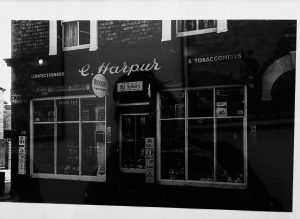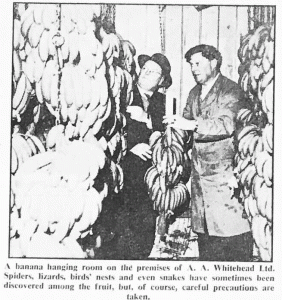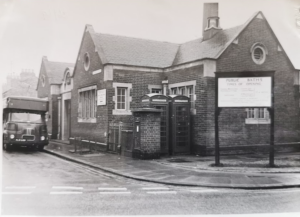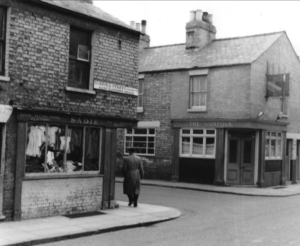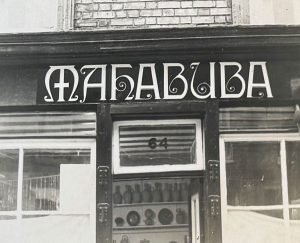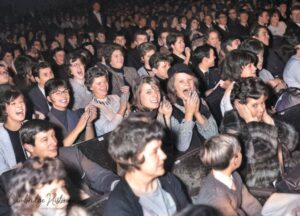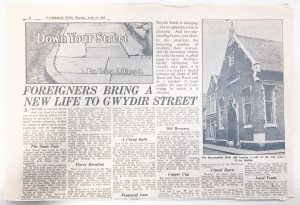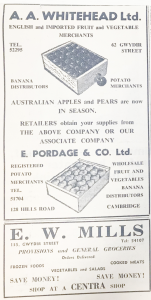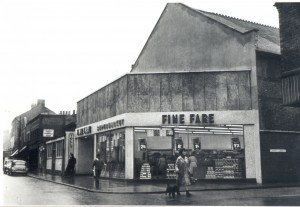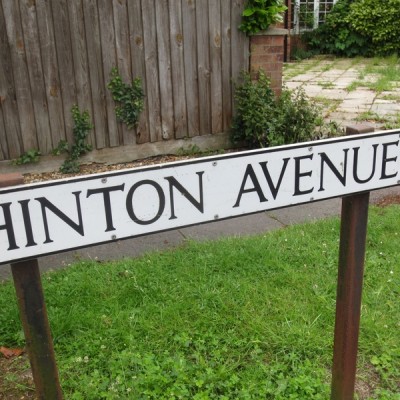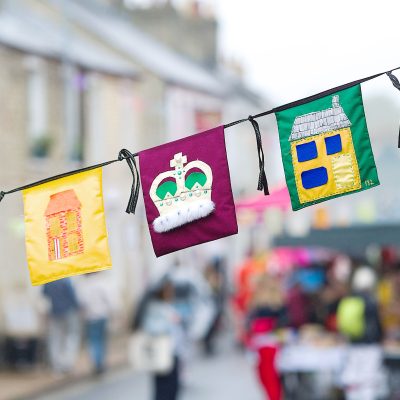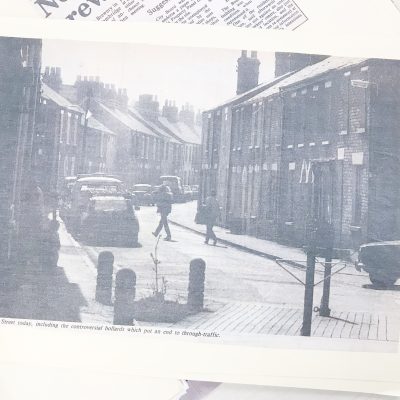Search by topic
- archaeology
- Building of Local Interest
- chapel
- charity
- church
- crime
- dressmaker
- fire
- Great Eastern Railway
- Listed building
- Mapping Relief
- medieval
- oral history
- poverty
- Public House
- Religious House
- Roman
- scholar
- school
- Then and Now
- tudor
- women
- work
- world war one
- world war two
Search by text
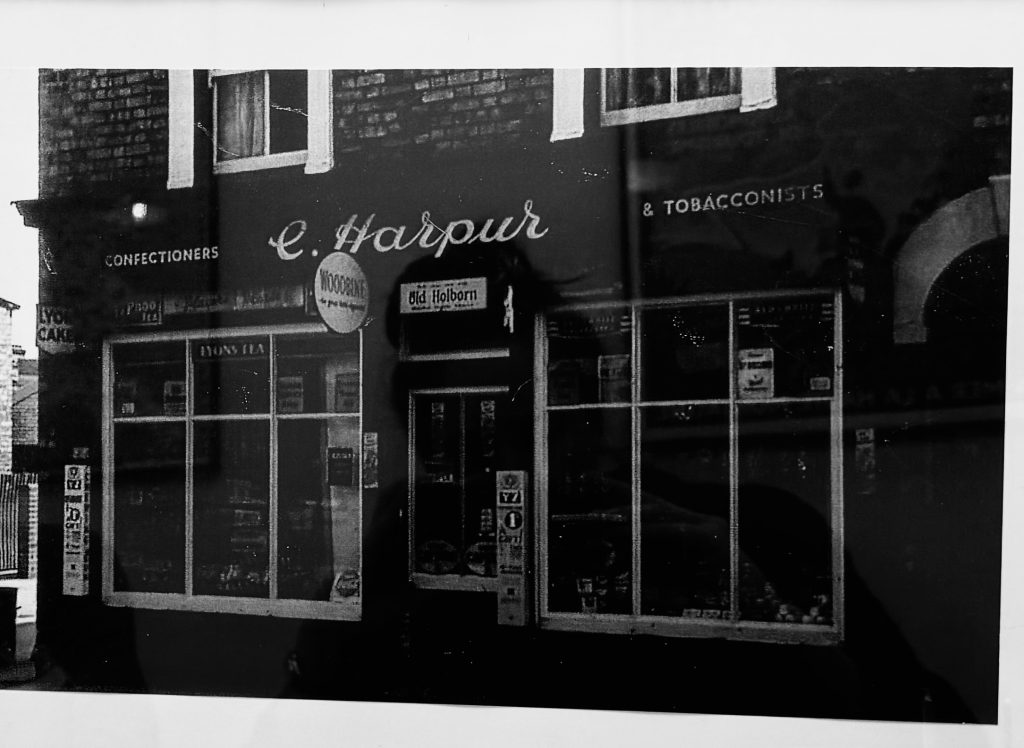 Harpur's shop opened in the 1950's at 64 Gwydir Street. Image courtesy of the Harpur family.
Harpur's shop opened in the 1950's at 64 Gwydir Street. Image courtesy of the Harpur family.Hazel & Charles – Gwydir Street
Siblings Hazel & Charles in conversation with Emmanuel
Hazel relocated to Gwydir Street with her family from a farm in Ireland when she was 8 years old. Her parents ran the Harpur’s cooperative shop at 64 Gwydir Street. In 1957 her brother Charles was born at Mill Road Maternity Hospital (now Ditchburn Place). Neighbour Emmanuel lives near Hazel and Charles’ former home and is an entrepreneur, originally from France.
The Harpur’s shop at 64 Gwydir Street
Hazel recalls the Harpur’s family shop where she soon began to help serve customers and get to know the neighbours. When the first supermarket opened on Mill Road in the late 50’s, the independent local shops on the street started to close.
Fruit merchants
The children saw enormous spiders crawling out of lorries delivering fruit to the local merchants.
Bath House and sauna
Playing in the streets
The Old School House – St Matthew’s
Mill Road Cemetery
Mahabuba opens at no. 64 in 1969
Musicians performing locally including Pink Floyd
Transcribed memory shared by Hazel
Moving to 64 Gwydir Street in 1955 (with my mother, father, older sister and younger brother) initially seemed very confined and dreary as I had spent the first eight years of my life living in the countryside (in Northern Ireland), on a farm, with the freedom of a large garden, an orchard and open fields all around. No. 64 was a shop (with living accommodation) selling groceries, such as “loose” bacon that had to be sliced with a sharp hand operated machine, and cheese that had to be cut with a wire. As well as groceries we sold cigarettes, tobacco, confectionery and much more. (My parents had also run a shop in Ireland as well as the farm). I very quickly started to serve in the shop to help my mother who was the main shop keeper as my father also went out to work.
Serving in the shop was a great way to meet all the neighbours and there were many names I still remember: Sanderson, Newman, Mr & Mrs Gent (49), Suggitt (60), Reeve (36), Kenneth Featherstone (25), Mrs H Lewis (58), Dee & Leonard S Hayden (47), Mrs Amelia Saunders (86), Stanley Charles Mason (88), Sidney Phillips (63), Senko, Albert Overhill (65), W P Wozniak (74) and many more. Teenager, Leslie Lewis at no. 58, fancied himself as a singer and gave renditions of rock’n‘roll songs accompanying himself on the skiffle board or on a make shift bass (which we children loved to hear).
I made friends with Joy Suggitt who lived at no. 60. a girl of about my own age and we became life long friends. My sister, Anna too became lifelong friends with a girl of her own age, Dierdre Dean who lived at no. 7 with her grandma Cecilia and great aunt while her mother worked in America (and returned later). Brother Roy became friends with John Smyth at number 3 (and we girls were friends with his sister, Angela).
Mrs. Gent was a beautiful young lady from South Africa. I think her husband, Peter, was in the navy and that’s how they met. They had young children as did Mrs. Featherstone, and Mrs. Hayden (Dee, who was a great friend of my mothers).
Another neighbour who frequented our shop we only knew her as “the cat lady”. She purchased tins of Kit-e-Kat, cat food, which she fed to the stray cats around Cambridge. She lived somewhere on the even side in the 50s.
I was good at wire cutting cheese to the weight the customer wanted and I was told “a good guesser never marries” (and I never did)!
“Foreigners bring a new life to Gwydir Street” in Down Your Street article by Erica J.Dimock in the Cambridge Evening News, 1963.04.25. Image courtesy Cambridgeshire Collection
Even back then (1955) the street had a diverse population – neighbours from Italy, Poland, and elsewhere, and us from Northern Ireland as well as a student population not only Cambridge University but also from CCAT (Cambridgeshire College of Arts and Technology) “the tech”, later called Anglia Polytechnic, then Anglia Polytechnic University and now Anglia Ruskin University.
When we first arrived, number 62 didn’t exist next door. It was a bombed site (from a bomb blast which mainly demolished houses (and the Methodist church) in Sturton Street in WW2). My brother, Roy who is two years younger than me, and I would rummage through the bricks and rubble in the hope of finding some treasure. Other evidence of WW2 was a large S on The Beaconsfield Club building on the corner of Gwydir and Milford Street (which no longer exists and the site is now a block of flats). The S was for shelter, I believe.
Later on, when the 62 site was developed as commercial premises in the 1960’s (initially fruit importers) on more than one occasion, Roy and I found very large spiders which had come in on the banana boxes and had made their way into our courtyard. Businesses there were A.A. Whitehead, Portages, and later, paint distributers Porch, before the site was redeveloped into four town houses.
A. A. Whitehead, E. Pordage and E. W. Mills fruit and vegetable merchants on Gwydir Street – 1963.04.25 Cambridge Evening News. Image courtesy the Cambridgeshire Collection
In those days (1955) the street lighting was gas lamps, which were quite dim and walking all the way down from either end of the street to number. Gwydir Street seemed endless (and a bit frightening for a young girl returning home from piano lessons or girl guides) in the eerie gas light. Often times, especially in winter when all the houses had coal fires burning, the atmosphere was unpleasant and “snoggy” – not only from the house chimneys, but also from the fumes coming from the gas works and and the steam billowing from the pumping station (now the Museum of Technology) both located near the river and at that time, considered to be an undesirable area (but now, like Gwydir Street, a bijou area).
Very few people had a car in those days and the street was devoid of traffic. Few houses had a bathroom and most had an outside toilet. There were public baths at the top of Gwydir Street and we would have a bath once a week! The 4d or 6d cost included a small towel and a small bar of carbolic soap. (Years later when the baths ceased to exist, saunas were installed, which was fantastic, sadly no longer).
Dales Brewery was opposite the baths and walking, on the way to St. Paul’s school with my friend Diana Thurston (14 Edward Street), we often had to wait while large oak barrels were rolled out of the brewery across the pavement to be loaded onto trucks. There was a lollipop man at the top of Gwydir Street who helped us cross Mill Road. Diana’s aunt owned a fish shop in St. Matthew’s Street and kept live eels in a white enamel basin.
Soon after we moved to the street my brother Charles was born. My mother welcomed my help before and after school to mind the shop. Our convenience store was open all hours from early in the morning until late at night and even when it was closed, neighbours would come and knock the back door. My parents were always obliging including allowing people to use our coin operated telephone.
There were at least four pubs, four or five little shops similar to ours and a post office in the street at that time but that was only until the first supermarket opened up. Fine Fare and was located where the Coop is on Mill Road the site that was previously Sally Anne’s. The small shops couldn’t compete with the Fine Fare as they could sell food for less than the small shops could buy it from the wholesalers. One by one the little shops all closed.
In 1961, we moved to number 59, which is a large house with a large garden which 64 didn’t have (which meant that as a teenager I had a room to myself). Our shop was still in business at that time. I didn’t live at 59 for long as I left home at 17 to work in Germany, Eastern Europe, London, and Bermuda).
Even though I was living in London at the time, in 1969 (during the height of the hippy era) I opened the up the shop again which was called Mahabuba (Beloved) (locally known as ”the far out shop” (way out). (I’d got some inspiration for the clothing I wanted to sell from a couple of shops I myself frequented to buy fashionable clothes – Forbidden Fruit in Portobello Road in London where I lived and Biba in Kensington. (My mother and sister were roped in to help). In addition to clothing, mostly imported from India and Pakistan (such as kaftans with embroidery and mirror work) and British Carnaby Street era clothes such a velvet trousers for men and women, I also sold crafts – jewellery, ceramics, hand blown glass, sculptures and déshabillé (designed by students at the Royal College of Art in London where I worked, plus sandals and pots from Greece, posters, candles, joss sticks, in fact, anything “far out” – while music blasted from the shop! – Bob Dylan, Leonard Cohen, Pink Floyd (we knew members of the band as these were local Cambridge boys). Not long ago I met a woman of my own age who told me that she had bought velvet trousers from Mahabuba and had recently sold them on eBay.
In 1974, when my parents put number 64 on the market, I offered £100 more than the highest bidder and bought it for £6,900. It’s been let out as residential accommodation ever since (proving to have been a very good investment).
Jill Eitrem owned no. 52 for many years up until recently, which was also let out.
No 59 was relinquished in 1997 following the death of my mother, Anna Dorothy, my father, Charles Mervyn, having died ten years prior.
Contribute
Do you have any information about the people or places in this article? If so, then please let us know using the Contact page or by emailing capturingcambridge@
License
This work is licensed under CC BY-NC-SA 4.0





